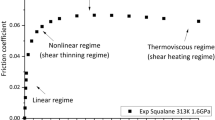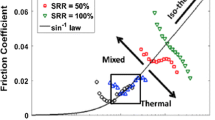Abstract
There can be no doubt that the assumptions used in modeling elastohydrodynamics for the temperature, pressure and shear rate dependence of viscosity are at odds with empirical fact. As a result, there has been relatively little progress since the classic Newtonian film thickness solutions toward relating film thickness and traction to the properties of individual liquid lubricants and it is not clear at this time that full numerical solutions can even be obtained for heavily loaded contacts using accurate models. One central issue is the validity of Reynolds equation, derived under the isoviscous assumption, for conditions where the local pressure-viscosity coefficient can approach 100 GPa−1. Some pressing problems are reviewed in this paper, including the effects of shear-thinning on film thickness and traction, and the proper definition of the pressure-viscosity coefficient for film thickness calculations. Wherever possible, for credibility, sources from outside of Tribology will be used. Then some opportunities for the field will be discussed. These opportunities result from advances in molecular dynamics simulations and improved techniques for high-pressure measurements and should shed light on the relationship between molecular structure and performance in contacts.
Access this chapter
Tax calculation will be finalised at checkout
Purchases are for personal use only
Preview
Unable to display preview. Download preview PDF.
Similar content being viewed by others
References
D. Dowson and G.R. Higginson, Elasto-Hydrodynamic Lubrication, Pergamon Press, Oxford, 1966, p. 69.
H. Blok, Inverse problems in hydrodynamic lubrication and design directives for lubricated flexible surfaces, in Proc. Intern. Symp. Lubrication and Wear, Muster and Sternlicht (eds), 1963, p. 74.
J. Zhao and F. Sadeghi, Analysis of EHL circular contact shut down, ASME J. Tribology, 125, 2003, 76–90.
R.P. Glovnea and H. A. Spikes, Elastohydrodynamic film collapse during rapid deceleration. Part I: Experimental results, ASME J. Tribology, 123, 2001, 254–261.
R.V. Kleinschmidt, D. Bradbury and M. Mark, Viscosity and Density of over Forty Lubricating Fluids of Known Composition at Pressures to 150,000 psi and Temperatures to 425 F, ASME, New York, 1953.
S. Bair, An experimental verification of the significance of the reciprocal asymptotic isoviscous pressure, STLE Tribology Transactions, 36, 1993, 153–162.
C.J.A. Roelands, Correlational aspects of viscosity-temperature-pressure relationship of lubricating oils, Thesis, Delft, 1966, p. 106.
A.J. Moore, The behavior of lubricants in elastohydrodynamic contacts, Proc. Instn. Mech. Engrs., 211(J), 1997, 91–106.
V.V. Brazhkin and A.G. Lyapin, Universal viscosity growth in metallic melts at megabar pressures: The vitreous state of the earth’s inner core, Physics Uspekhi, 43(5), 2000, 493–508.
A. Dandridge and D.A. Jackson, Measurements of viscosity under pressure: A new method, J. Physics, D: Appl. Physics, 14, 1981, 829–831.
M. Renardy, Some remarks on the Navier-Stokes equations with a pressure-dependent viscosity, Comm. in Partial Diff. Eqn., 11(7), 1986, 779–793.
S. Bair, M. Khonsari and W.O. Winer, High-Pressure rheology of lubricants and limitations of the Reynolds equation, Trib. Intern., 31(10), 1998, 573–586.
C.T. Schaefer, P. Giese, W.B. Rowe and N.H. Woolley, elastohydrodynamically lubricated line contact based on the Navier-Stokes equations, in Proc. 26th Leeds-Lyon Symp. Trib., Elsevier, Amsterdam, 2000, pp. 57–59.
T. Almqvist and R. Larsson, The Navier-Stokes approach for thermal EHL line contact solutions, Trib. Intern., 35, 2002, 163–170.
K.R. Rajagopal and A.Z. Szeri, On an inconsistency in the derivation of the equations of elastohydrodynamic lubrication, Proc. Roy. Soc. Lond. A, 459, 2003, 2771–2786.
J. Hron, J. Malek and K.R. Rajagopal, Simple flows of liquids with pressure-dependent viscosities, Proc. Roy. Soc. Lond. A, 457, 2001, 1603–1622.
S. Bair and C. McCabe, A study of mechanical shear bands in liquids at high pressure, Trib. Intern., 37(10), 2004, 783–789.
R.B. Rhodes, Development of ASTM Standard Test Methods for measuring engine oil viscosity using rotational viscometers at high-temperature and high shear rates, in High-Temperature, High-Shear (HTHS) Oil Viscosity: Measurement and Relationship to Engine Operation, ASTM STP 1068, James A. Spearot (ed.), American Society for Testing and Materials, Philadelphia, 1989, pp. 14–22.
S. Bair, A more complete description of the shear rheology of high-temperature, high-shear journal bearing lubrication, STLE Trib. Trans., accepted 2004.
S. Bair and F. Qureshi, The high-pressure rheology of polymer-oil solutions, Trib. Intern., 36, 2003, 637–645.
C.R. Schultheisz and S.D. Leigh, Certification of the rheological behavior of SRM 2490, Polyisobutylene dissolved in 2,6,10,14-Tetramethylpentadecane, NIST Special Publication 260-143, 2002, pp. 2–27.
S. Bair, C. McCabe and P.T. Cummings, Calculation of viscous EHL traction for Squalane using molecular simulation and rheometry, Trib. Lett., 13(4), 2002, 251–254.
F.H. Ree, T. Ree and H. Eyring, Relaxation theory of transport problems in condensed systems, Ind. Eng. Chem., 50, 1958, 1036–1038.
S.J. Hahn, H. Eyring, I. Higuchi and T. Ree, Flow properties of lubricating oils under pressure, NLGI Spokesman, 21(3), 1958, 123–128.
S. Bair, The high pressure rheology of some simple model hydrocarbons, Proc. Instn. Mech. Engrs., 216(J), 2002, 139–149.
D.W. Van Krevelen, Properties of Polymers, 3rd Edition, Elsevier, Amsterdam, 1990, pp. 475–486.
S. Bair, The high-pressure rheology of mixtures, ASME J. Tribology, Paper 1040, 2004.
M.J.A. Holmes, H.P. Evans, T.G. Hughes and R.W. Snidle, Transient elastohydrodynamic point contact analysis using a new coupled differential deflection method. Part 2: Results, Proc. Instn. Mech. Engrs., 217(J), 2003, 305–321.
L.I. Kioupis and E.J. Maginn, Rheology, dynamics, and structure of hydrocarbon blends: A molecular dynamics study of n-Hexane/n-Hexadecane mixtures, Chem. Eng. J., 74, 1999, 129–146.
S. Bair, Complete isothermal solution for the viscous regime of concentrated contact traction, Intl. J. Appl. Mech. Engr., 7(3), 2002, 719–727.
J.F. Hutton and M.C. Phillips, Shear modulus of liquids at elastohydrodynamic pressures, Nature Phys. Sci., 238, 1972, 141–142.
K.L. Johnson and J.L. Tevaarwerk, Shear behavior of elastohydrodynamic oil films, Proc. Roy. Soc. Lond. A, 356, 1977, 215–236.
S. Bair, The nature of the logarithmic traction gradient, Trib. Intern., 35, 2002, 591–597.
S. Bair, Ordinary shear-thinning behavior in liquids and its effect upon EHL traction, in Tribology Research: From Model Experiment to Industrial Problem, G. Dalmaz et al. (eds), Elsevier, 2001, pp. 733–742.
J.A. Greenwood, Two-dimensional flow of a non-Newtonian lubricant, Proc. Instn. Mech. Engrs., 214(J), 2000, 29–41.
S. Bair and F. Qureshi, Ordinary shear-thinning behavior and its effect upon EHL film thickness, in Proc. 29th Leeds-Lyon Symp., Tribology, Elsevier, Amsterdam, 2003, pp. 693–699.
R.C. Gunderson and A.W. Hart, Synthetic Lubricants, Reinhold, New York, 1962, pp. 87–88.
C. McCabe, C.W. Manke and P.T. Cummings, Predicting the Newtonian viscosity of complex fluids from high strain rate molecular simulations, J. Chem. Phys., 116(8), 2002, 3339–3342.
S. Bair, McCabe and P.T. Cummings, Comparison of non-equilibrium molecular dynamics with experimental measurements in the nonlinear shear-thinning regime, Phys. Rev. Lett., 88(5), 2002, 058302.
P.A. Gordon, Characterizing isoparaffin transport properties with Stokes-Einstein relationships, Ind. Eng. Chem. Res., 42(26), 2003, 7025–7036.
P.A. Gordon, Extrapolation of rheological properties for lubricant components with Stokes-Einstein relationships, to be submitted.
M.G. Martin and J.I. Siepman, Novel configurational-bias Monte Carlo method for branched molecules. Transferable potentials for phase equilibria. 2. United-atom description of branched alkanes, J. Phys. Chem. B, 103(21), 1999, 4508–4517.
Author information
Authors and Affiliations
Editor information
Editors and Affiliations
Rights and permissions
Copyright information
© 2006 Springer
About this paper
Cite this paper
Bair, S., Gordon, P. (2006). Rheological Challenges and Opportunities for EHL. In: Snidle, R.W., Evans, H.P. (eds) IUTAM Symposium on Elastohydrodynamics and Micro-elastohydrodynamics. Solid Mechanics and Its Applications, vol 134. Springer, Dordrecht . https://doi.org/10.1007/1-4020-4533-6_2
Download citation
DOI: https://doi.org/10.1007/1-4020-4533-6_2
Publisher Name: Springer, Dordrecht
Print ISBN: 978-1-4020-4532-5
Online ISBN: 978-1-4020-4533-2
eBook Packages: EngineeringEngineering (R0)




